Do you cringe every time you pay through your teeth for probiotics? And feel guilty about not using up all the veg in your fridge? Then learning how to ferment is for you.
Last week I went to a workshop run by nutritionist and fermentation expert Asa Simonsson for Made in Hackney, an awesome organisation aiming to teach communities how to eat healthy food on an affordable budget. In two hours Asa taught us how to do a sauerkraut, a fermented vegetable mix and her own delicious version of Korean spicy kimchi.
And since discovering it was a easy way to make sure no veg goes to waste, I used up all of my kilner jars, fermenting anything I could lay my hands on. Now I’m plotting new recipes and dreaming of new pairings, so watch out for new Skandi flavours soon showing up in my kitchen creations.
Asa is Swedish and her aunt runs an organic farm and fermented vegetables company. She has been fermenting all her life and just about anything on earth. I on the other hand, could not have been further from this universe. Fermented vegetables are just not eaten in Italy. We traditionally pickle food in delicate carpione marinades (see recipe here) and rely on fresh cheese (some of it fermented) for the beneficial bacteria in our diet. Since moving here, discovering more about the amazing power of bacteria and seeing for myself how healing one’s digestive tract can transform one’s life, I started dabbling with making my own kefir and kombucha (really easy and satisfying) but never really been satisfied with my efforts at fermentation.
The simple process of fermenting vegetables does wonders to their nutritional properties: vitamin C, one of the first to perish, lasts in fermented foods for several months. Vitamin B12, one of the trickiest to get especially for vegetarians, is created during fermentation. Omega 3 content is increased. Fermented vegetables not only have more probiotic strains than any commercially available probiotic capsule: they also contain lots of digestive enzymes and antioxidants and increase the bioavailability of many essential minerals and vitamins.
All these nutrients help heal our digestion and our mind: they have a calming effect on the mood, lower blood pressure and help keep blood sugar levels stable. When you crave chocolate, reach for sauerkraut instead, said Asa: it seems strange, but it works.
Now my vegetables have only been fermenting for a week. I tried tasting some and the fermented taste is still slight. To reap all the benefits of fermented food you should really leave it for a couple of weeks. So I’m still waiting.
Here are some pictures. The recipe is Asa’s so I won’t divulge all her secrets.
But you can try mixing chopped up or blended vegetables (organic work best), adding enough natural salt (sea salt or crystal salt but definitely NOT cooking salt) to help draw out the moisture. Massage your vegetables with your hands, trying to squeeze as much liquid out as possible, then stuff the mix into a sterilised jar, pressing it down as much as you can. You can also add herbs such as cumin or coriander seeds, and flavour your ferment with ginger or garlic. Just remember each flavour will be amplified, so go easy on strong flavours.
Make sure the veg is fully covered by the liquid and if necessary add some water (make sure it’s filtered). Use a block of some sort to keep the vegetables under the liquid level and cover the top with a cabbage leaf: if it goes mouldy, don’t worry as the mould won’t be able to get under the water level and contaminate the rest of the jar.
Important tip to avoid unwanted explosions: ensure the jars are not full to the brim, leaving space for the carbon dioxide to escape, and remember to ‘burp’ your jars every day or so, by just opening them up for a second to let the gas out. This way your walls will be safe.
If for any reason at the end of this process your veg smells like something you wouldn’t eat, something must have gone wrong. But listening to Asa, as long as you kept your jars, hands and surfaces clean, this should not happen. I have been vague with my instructions because all I know about fermentation I learnt from her. If this post made you curious about trying your hand at fermentation, that’s great. Contact her or Made in Hackney about joining one of her workshops or you can read all about this topic in an excellent book I just received from the library. It’s The Art of Fermentation By Sandor Ellix Katz. I really recommend this to anyone who wants to know more about this fascinating subject.
Health score? 20 out of 10, of course!

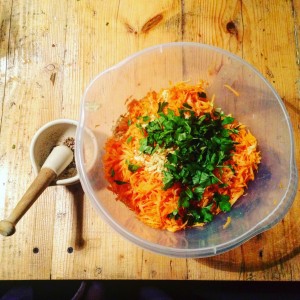
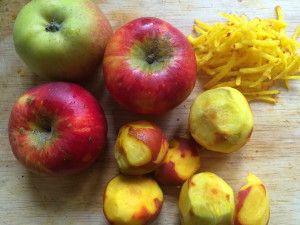
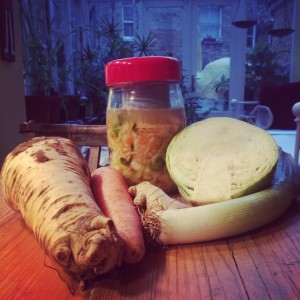
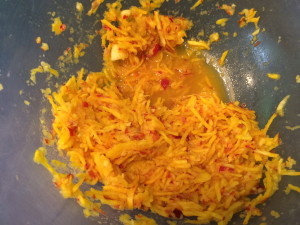
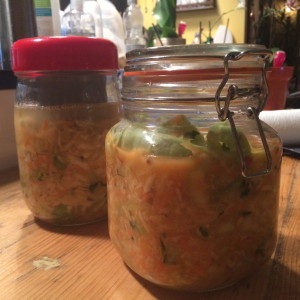
Hey Carolina,
I’m looking forward to reading more about this. Please let me know how it goes in a few weeks time.
BTW. What food do Italians eat at Xmas? any recipes?